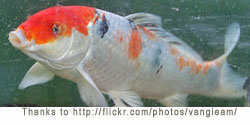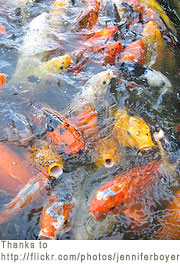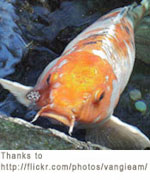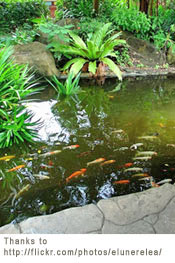Koi

History of Koi Fish
Koi is a species of carp that has been bread over centuries to have certain characteristics. Similar to dog breeding, the koi fish have been bred with show quality characteristics and have become prized fish.The history of the koi dates back to about 200 AD and Japanese transcripts mention these fish, however not much is known about the history of the Koi. Speculation is that because it is an extremely hardy fish, it flourished and was able to be transported throughout Europe and the popularity of these large and elegant fish grew. It was last bred in japan as a source of food. They were also symbol of luck so they were commonly kept by people.
Koi are a long lived fish averaging 80 years! they grow very large, females can be 30 inches and males can grow to up to 36 inches long. They will reach full grown size after a few years but it greatly depends on environmental conditions. They need consistent conditions, proper food and a large and deep enough space to obtain maximum size
Difference Between Koi and Gold Fish
They both originate from the same species of wild carp. Goldfish were bread specifically for ornamental purposes by the Chinese and the Japanese bred the carp to become strong and large as a source of food. Today, the common variety of goldfish, or comet goldfish and young koi can resemble each other allot, which makes sense since they are closely related.Keeping Koi
 They are traditionally kept as pond fish and this is where they thrive the best. If you live in water climates, you can keep your koi outside all year long.
They are traditionally kept as pond fish and this is where they thrive the best. If you live in water climates, you can keep your koi outside all year long. If you live in colder climates where the water in your pond will freeze, you can either house your koi inside in an extra large aquarium or use a de-icer that floats in your pond, basically acting as a heater and allowing your koi to receive oxygen through the hole in the ice. The most common solution to winter is to continue to house them in the pond because for a full grown 30 inch koi, you will need an extremely large fish tank and for most, this is unpractical. You local tropical fish store will be able to show you pond products to buy for your backyard pond to allow your koi fish to survive during winter.
Koi are hardy and can live in water conditions that range from 40F to 70F F. It is important to provide a shady spot for your koi to get out of the sun since they can be sunburned and overheated in the hot summer sun. Another good tip is to make sure you have a deep spot so they can retreat to the bottom to stay cool during the hot summer days.
During the chilly winter months, koi go into a state of hibernation where they hardly move and do not eat as because the metabolism slows. This is natural behavior for koi to hibernate in the winter months.
Add water plants to your pond such as lily pads and hornwort. This serves a few purposes. Firstly, it aids in the biological filtration of your pond. Additionally, it provides shady spots for your koi fish to hide and hides them from predators like large birds of prey and local cats. Plants are very important additions to your pond and add aesthetic value in addition to the other benefits listed above. We highly recommend pond plants.
Koi are large messy fish the excrete allot of waste so proper filtration is important. Adding a waterfall decoration to your pond not only looks good but will help to oxygenate the eater as well, helping to reduce nitrate and ammonia. Treat your pond like a giant outdoor aquarium. You should have a filter that is large enough to handle the volume of water. In addition to fish waste, you have to deal with outdoor elements such as sticks, leaves, and other natural elements. Visit your local fish store for recommendations on pond filters. Filtration is extremely important or your pond will quickly deteriorate and turn into a murky or algae filled mess. It is recommended to get a UV sterilizer to prevent any algae bloom problems. Do not penny pinch on your pond equipment or you will almost literally have a swamp in your backyard!
For sizing your pond, allow 10 gallons per inch of fish. Also make sure that your pond is about 2 feet deep. remember that koi grow to be large fish, over 12 inches long so keep in mind your ratio of inches of fish per gallon of water for the full grown size of koi.
We won't get into the specifics on setting up a pond right now as this article is about Koi fish care only, that will come as a separate article.
How to Select Koi
 Know that koi will change their look as they age. Their colors may spread and the patterns will vary, the koi you see at a few months age may look completely different after many years. With that said, do not solely choose your koi on it's current color pattern or as it will change over time, rather you should select a healthy specimen.
Know that koi will change their look as they age. Their colors may spread and the patterns will vary, the koi you see at a few months age may look completely different after many years. With that said, do not solely choose your koi on it's current color pattern or as it will change over time, rather you should select a healthy specimen. Look for a straight spine and large mouth with firm whiskers and a large dorsal fin this indicates a large sized koi when mature. Look for koi that are actively swimming and not sitting on the bottom.
When you arrive home, float your koi in the pond for 20 minutes in the bag of water similar to the way you float your fish when introducing them to an indoor aquarium. Even though Koi are very hardy fish, a sudden change of water conditions will shock any fish.
Feeding Koi
You will notice Koi food in varying price ranges. The expensive brands of Koi food are formulated with various ingredients to simulate what the carp species (where koi originate from) eat in the wild. They are omnivorous fish, eating both plant and animal matter. Koi will eat anything they can fit into their mouth. Feed you koi a mixture of floating Koi pellets, color-enhancing pellets and various colored Koi pellets. The more variety, the better. Alternate the types of food every feeding. The different colors signify different nutrients in the food for example green pellets are high in plant matter and red pellets are high in animal matter.Feed your Koi daily and only the amount they can consume in 5 minutes. Remove any excess immediately as it will rot and cause water problems. Remember that koi will eat insects so even when you do not feed them, they still find something to eat.
Proper water conditions and not over-feeding are essential to healthy fish. however Koi can be prone to diseases such as dropsy and fin-rot. If you encounter either of these problems in your fish, visit our tropical fish diseases section for care tips but remember that treating disease in a pond may be different then an aquarium so consult your local fish store for pond medications.
